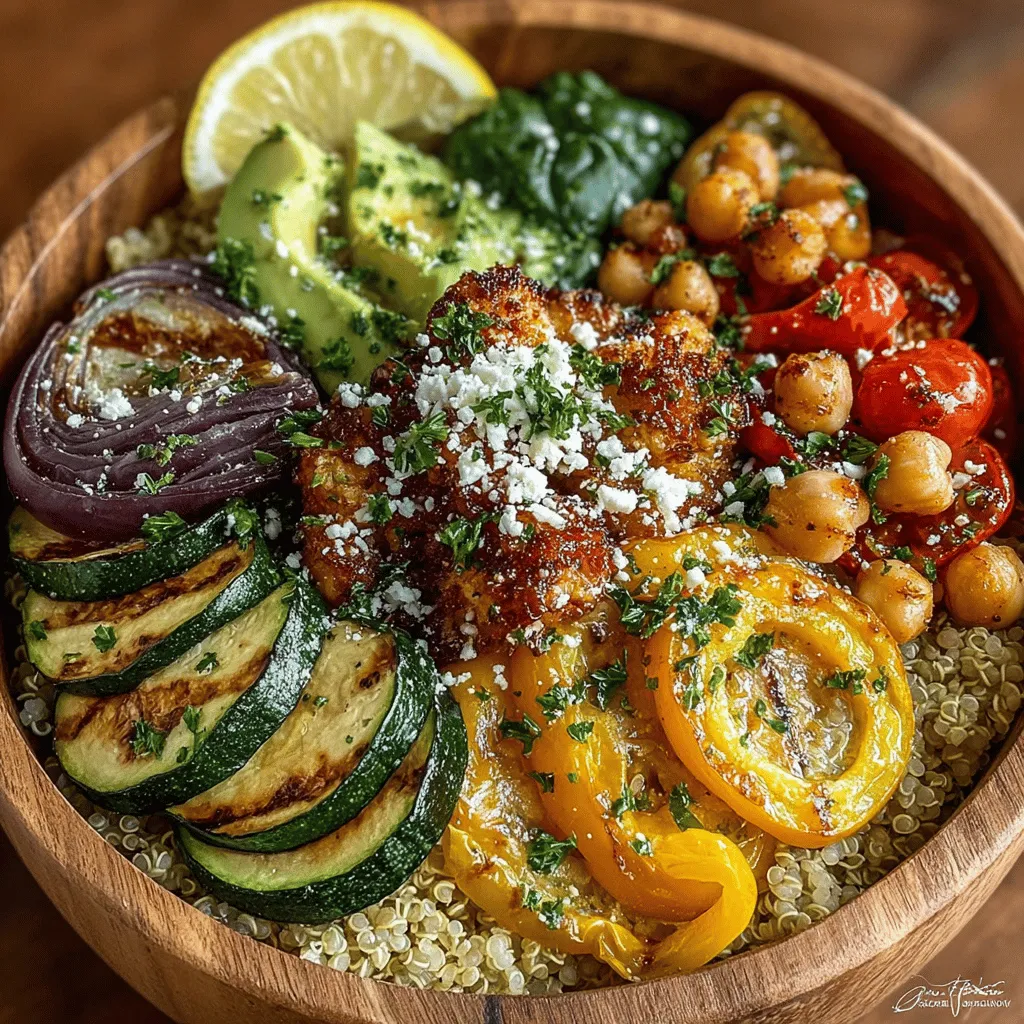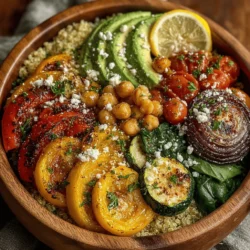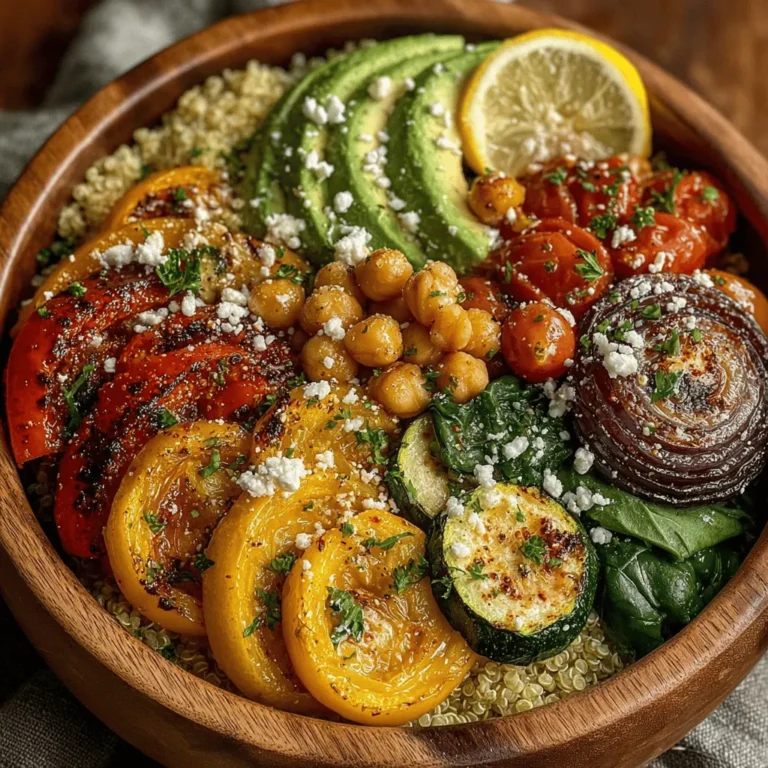Power bowls have taken the healthy eating scene by storm, offering a delicious and nutritious way to enjoy a balanced meal in one dish. These versatile bowls typically feature a base of grains, topped with a variety of vegetables, proteins, and flavorful dressings. In this recipe, we highlight quinoa and roasted vegetables, which not only provide a nutrient-dense foundation but also cater to various dietary preferences. Whether you are meal prepping for the week or looking for a satisfying lunch or dinner option, this quinoa and roasted veggie power bowl is a fantastic choice.
Ingredients
– 1 cup quinoa
– 2 cups water or vegetable broth
– 1 red bell pepper, diced
– 1 zucchini, sliced
– 1 yellow squash, sliced
– 1 cup cherry tomatoes, halved
– 1 red onion, chopped
– 1 can (15 oz) chickpeas, drained and rinsed
– 2 cups fresh spinach or kale
– 2 tablespoons olive oil
– Salt and pepper to taste
– Optional: 1 avocado, sliced
– Optional: 1/2 cup feta cheese, crumbled
Instructions
1. Preheat the oven to 400°F (200°C).
2. In a medium saucepan, combine the quinoa and water (or vegetable broth). Bring to a boil, then reduce the heat to low, cover, and simmer for about 15 minutes or until the quinoa is fluffy and the liquid is absorbed. Remove from heat and let it sit covered for 5 minutes.
3. While the quinoa cooks, prepare the vegetables. In a large mixing bowl, combine the diced red bell pepper, sliced zucchini, yellow squash, halved cherry tomatoes, chopped red onion, and drained chickpeas.
4. Drizzle the vegetable mixture with olive oil, and season with salt and pepper. Toss until all the vegetables are well-coated.
5. Spread the vegetable and chickpea mixture evenly on a baking sheet lined with parchment paper.
6. Roast in the preheated oven for 20-25 minutes, stirring halfway through, until the vegetables are tender and slightly caramelized.
7. Fluff the cooked quinoa with a fork and season with additional salt and pepper, if desired.
8. To assemble the power bowls, divide the quinoa among serving bowls. Top with the roasted vegetables, spinach or kale, and any optional toppings such as sliced avocado or crumbled feta cheese.
Understanding the Ingredients
Overview of Quinoa
Quinoa is often hailed as a superfood due to its impressive nutritional profile. It is a complete protein, containing all nine essential amino acids, making it a fantastic grain alternative for those following a plant-based diet. Additionally, quinoa is high in fiber, which supports digestive health and helps maintain a feeling of fullness. This ancient grain is gluten-free and versatile, making it a preferred choice among health-conscious individuals.
Benefits of Roasted Vegetables
Roasting vegetables not only enhances their natural flavors but also adds a delightful texture to dishes. In this recipe, we use bell peppers, zucchini, yellow squash, cherry tomatoes, and red onion, each providing unique health benefits. For instance, bell peppers are rich in vitamin C, while zucchini and squash are low in calories and high in water content, contributing to hydration. Roasting caramelizes the sugars in these vegetables, resulting in a sweet and savory profile that elevates the overall taste of the power bowl.
Chickpeas as a Protein Source
Chickpeas, or garbanzo beans, are an excellent addition to this power bowl, providing a substantial source of plant-based protein and fiber. They are incredibly versatile and can be used in various cuisines, from Mediterranean to Indian dishes. Not only do they enhance the nutritional value of the meal, but their nutty flavor and hearty texture also contribute to the bowl’s overall satisfaction.
The Power of Leafy Greens
Leafy greens, such as spinach or kale, are essential components of a healthy diet. They are packed with vitamins A, C, and K, as well as minerals like iron and calcium. Adding these greens to your power bowl not only boosts its nutrient content but also adds a fresh and vibrant touch to the dish.
Optional Additions: Avocado and Feta
For those looking to enrich their power bowl further, adding sliced avocado provides healthy fats and a creamy texture. Avocado is known for its heart-healthy monounsaturated fats, which can help reduce bad cholesterol levels. Feta cheese can also be included for those who enjoy dairy; it adds a salty and tangy flavor that complements the other ingredients. For those avoiding dairy, simply omit the feta or replace it with a dairy-free alternative.
Step-by-Step Cooking Instructions
Preheating the Oven
Preheating the oven is a crucial step for achieving perfectly roasted vegetables. It ensures even cooking and allows for that desirable caramelization to occur, enhancing both flavor and texture.
Cooking the Quinoa
Cooking quinoa is straightforward, but it’s important to rinse it before cooking to remove any bitterness. The water or broth used for cooking can also infuse additional flavor into the quinoa, making it a tasty base for the power bowl.

Tips for Rinsing and Cooking Quinoa
Rinsing Quinoa for Maximum Fluffiness
To ensure your quinoa comes out fluffy and free of any bitterness, it’s crucial to rinse it thoroughly before cooking. Place the quinoa in a fine-mesh strainer and rinse it under cold running water for about 1-2 minutes. This process removes the saponins, a natural coating that can impart a bitter flavor. After rinsing, drain the quinoa well to avoid excess water in the cooking process.
Cooking Quinoa with Vegetable Broth
For enhanced flavor, cook your rinsed quinoa in vegetable broth instead of water. The typical ratio is 1 cup of quinoa to 2 cups of broth. Bring the liquid to a boil, then reduce the heat, cover, and simmer for approximately 15 minutes or until the quinoa has absorbed all the liquid. Once cooked, let it sit covered for an additional 5 minutes before fluffing it with a fork. This technique not only boosts the taste but also enriches the nutritional profile of your dish.
Preparing and Roasting the Vegetables
Proper Chopping and Seasoning
Choosing the right vegetables is key to a delicious power bowl. Common choices include bell peppers, zucchini, carrots, and red onions. Chop the vegetables into uniform pieces to ensure even cooking. Toss them in a bowl with olive oil, salt, pepper, and your choice of herbs or spices (such as paprika or garlic powder) to enhance their flavors.
The Importance of Even Roasting
Spread the seasoned vegetables on a baking sheet in a single layer, ensuring they have enough space to roast evenly. Preheat your oven to 425°F (220°C) and roast for about 20-25 minutes. Flip the vegetables halfway through to promote even caramelization, which brings out their natural sweetness and adds depth to the dish.
Heating the Chickpeas
Effective Heating Techniques
For added protein and texture, canned chickpeas can be a great addition to your power bowl. Drain and rinse the chickpeas, then heat them in a skillet over medium heat for about 5-7 minutes. This method not only warms them through but also allows them to crisp up slightly for a delightful crunch.
Seasoning Options
To elevate the flavor of your chickpeas, consider seasoning them with spices like cumin, coriander, or even a dash of cayenne for heat. A splash of lemon juice can also brighten their flavor profile.
Assembling the Bowls
Layering Ingredients
When it comes to assembling your power bowls, start with a base of quinoa, followed by a generous layer of roasted vegetables and chickpeas. This layering not only looks appealing but also ensures a balanced mix of flavors and textures in each bite.
Balancing Flavors and Textures
Aim for a harmonious combination of flavors and textures in your bowl. The nuttiness of quinoa, the sweetness of roasted veggies, and the creaminess of chickpeas create a satisfying experience.
Garnishing and Serving
Garnish Suggestions
To finish off your power bowl, consider garnishing with fresh herbs like parsley or cilantro, a sprinkle of feta cheese, or a handful of nuts or seeds for added crunch. These elements not only enhance the visual appeal but also add layers of flavor.
The Role of Lemon
A squeeze of fresh lemon juice can work wonders in brightening the overall flavor of your dish, balancing the richness of the roasted vegetables and chickpeas.
Nutritional Information
Each serving of Quinoa and Roasted Veggie Power Bowl provides approximately:
– Calories: 450
– Protein: 15g
– Carbohydrates: 65g
– Fats: 15g
This dish is rich in protein, fiber, and essential nutrients, making it an excellent choice for a balanced diet. Its combination of complex carbohydrates and healthy fats can help provide sustained energy throughout the day.
Variations and Customizations
Alternative Vegetables
Feel free to swap out the vegetables based on seasonal availability. Seasonal choices such as asparagus in spring or sweet potatoes in fall can introduce new flavors and textures to your bowl.
Dietary Adaptations
This recipe is inherently vegan and gluten-free, making it suitable for various dietary needs. You can easily adapt it further by incorporating protein sources like grilled chicken or tofu for additional heartiness.
Additional Toppings
Consider adding avocado, a dollop of hummus, or a drizzle of tahini sauce for a personalized touch. Each of these options can enhance flavor while contributing to the nutritional value of your meal.
Conclusion
Quinoa and Roasted Veggie Power Bowls are an excellent nutritious meal option that caters to various dietary preferences. They are not only easy to prepare but also versatile enough to suit different lifestyles and seasonal ingredients. Enjoy the process of creating this healthy dish and feel free to explore your own variations, making it a staple in your meal rotation.


